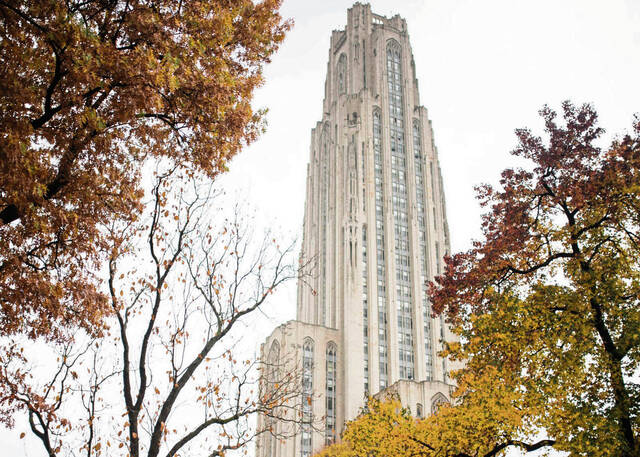Residents and community leaders remain at odds about a package of proposed zoning changes for Pittsburgh’s Oakland neighborhood.
The future of development and zoning regulations in the neighborhood has been a hotly contested issue for months as a controversial development, neighborhood plan and zoning package have left the neighborhood divided.
The Oakland Plan — a document intended to guide development in the neighborhood for years to come — earned Planning Commission approval in June. At the same time, commissioners recommended a package of related zoning changes to City Council for approval.
The zoning amendments before City Council are “an implementation action of the Oakland Plan,” Deputy Director of City Planning Andrew Dash said Wednesday at a public hearing on the zoning proposals.
The measure includes three new base zoning districts that would apply to portions of the Oakland neighborhood:
- Urban Center - Employment, where zoning would allow for a wide range of commercial uses and multi-unit residential housing only if all units are affordable or if residential use makes up no more than half of the property’s gross square footage.
- Urban Center - Mixed Use, where there would be a wide range of commercial and residential uses.
- Residential - Mixed Use, where zoning would allow residential uses, plus some smaller-scale commercial uses
Also included in the zoning package is a proposal to expand inclusionary zoning into Oakland. Inclusionary zoning — which is currently in effect in the city’s Lawrenceville, Bloomfield and Polish Hill neighborhoods — requires that housing developments of 20 or more units to have at least 10% of their units be considered affordable housing.
Like the related Oakland Plan, the zoning changes have sparked controversy among Oakland residents, businesses and developers.
“Obviously in Oakland there are a lot of competing interests, a lot of goals that are competing as well,” Dash said, noting that some residents are concerned about increasing density and building sizes, while some businesses and institutions want to see more opportunities for major developments in Oakland.
The zoning proposals, Dash said, are aiming to “create that balance.”
Some community members, however, don’t feel the proposals are accommodating their needs.
One major debate has revolved around building sizes, with some arguing they should be allowed to construct even larger buildings, and others arguing the allowed sizes should be scaled back.
In June, City Council approved a zoning amendment to clear the way for a controversial development dubbed Oakland Crossings. Since then, however, that measure has been tweaked and the legislation now before City Council would shrink the building sizes they had said they would permit.
This comes as there has been significant debate about how long and how tall buildings should be.
Building lengths in the Urban Center - Mixed Use section were previously to be capped at 400 feet. Now, the zoning proposal would allow buildings to be no longer than 250 feet — except for grocery stores, which would still be allowed to stretch to 400 feet.
“It is still too long, as 250 feet is a city block,” said Elena Zaitsoff of the Oakcliffe Community Organization.
Such a change would have a “significant impact” on developments like Oakland Crossings, said Karen Brean, a planning consultant for Walnut Capital, the local developer behind the Oakland Crossings proposal.
Several other buildings throughout the city — including the Allegheny County Courthouse, Heinz Hall and the Carnegie Library and Museum in Oakland — would not have been allowed to be built by that standard, she said.
Related:
• Pittsburgh Planning Commission adopts Oakland Plan as concerns persist about proposed zoning changes• Pittsburgh zoning amendment clears way for proposed Oakland Crossings
• Oakland Plan aims to bolster jobs, affordable housing, green space, other community needs
L.W. Molnar & Associates Inc. is developing the Oakland Portal site, which sits closer to the Monongahela River at the Fifth and Forbes corridor at Craft Avenue.
Andrew Molnar of L.W. Molnar & Associates Inc. said the proposed zoning changes will drastically restrict the developer’s plan for Oakland Portal. He said the zoning would prohibit Molnar from building any market-rate housing on the site, as it sits in the Urban Center - Employment zone.
Molnar said the zoning’s height limits would severely restrict the type of office tenant it hopes to attract, and the linear frontage limits — or width — wouldn’t allow them to develop to the scale that is necessary for the companies looking to move into Oakland, such as ones in the technology and life sciences sectors.
“We are trying to build a project that can attract the companies that can compete with cities like Boston and Raleigh and Austin,” Molnar said.
He said Oakland Portal should have zoning similar to what was approved just blocks away at Oakland Crossings, so the development can attract office space, retail and housing for people who would live, work and shop there. Molnar said zoning should embrace Oakland’s growth.
The new zoning changes also could “significantly impede” plans at the University of Pittsburgh, said Charles Alcorn, a planner with the university. He urged council members to send the proposal back to the Planning Commission.
Oakland Business Improvement District CEO Georgie Petropoulos said the proposed zoning changes were not presented to the steering committee and she is asking City Council for more time to review them before it votes on them.
She said Oakland has rebounded extremely well out of the pandemic and that zoning should accommodate that growth. The Oakland Business Improvement District has conducted foot traffic studies and Petropoulos said Oakland’s business district has seen 102% of the foot traffic compared to 2019, before the pandemic.
That is in contrast with Downtown Pittsburgh, which has not fully recovered since the pandemic and is now moving to a more residential-focused development strategy.
Petropoulos said technology and life-science companies have expressed interest in moving to Oakland. She said zoning should increase height limits to accommodate these companies.
The inclusionary zoning piece received support from several in the Oakland community, who acknowledged the need for more affordable housing.
“We know that Oakland needs more affordable housing. I think that’s an undisputed fact,” said Christina Howell, executive director of the Bloomfield Development Corp., which recently supported expanding inclusionary zoning into Bloomfield.
Eric Macadangdang, a graduate student at the University of Pittsburgh, said inclusionary zoning is “the bare minimum we can do” in the midst of a housing crisis that has priced many residents out of their neighborhood.
Councilwoman Erika Strassburger, who represents a portion of the Oakland neighborhood, said she is in favor of “slowing down the process” to consider community input on the matter.
Councilman Bruce Kraus, who also represents part of the neighborhood, recessed the public hearing and promised to hear additional public feedback if more changes are made to the proposed zoning. He also called for a briefing with council members to further discuss the complex zoning matters before considering a vote on the measure.








